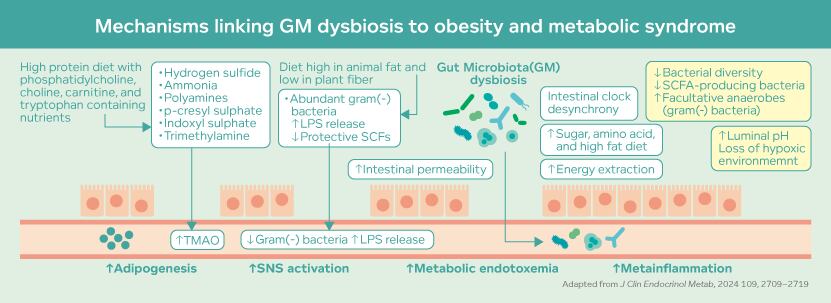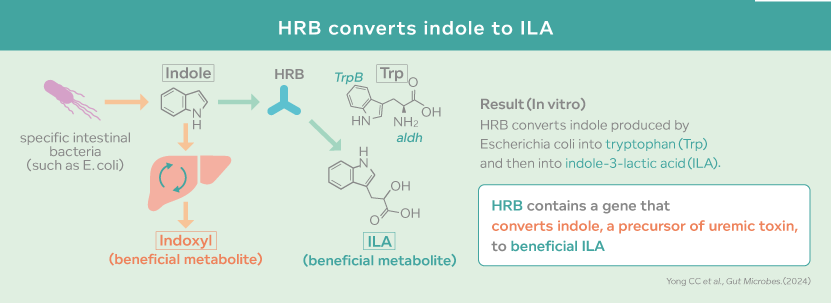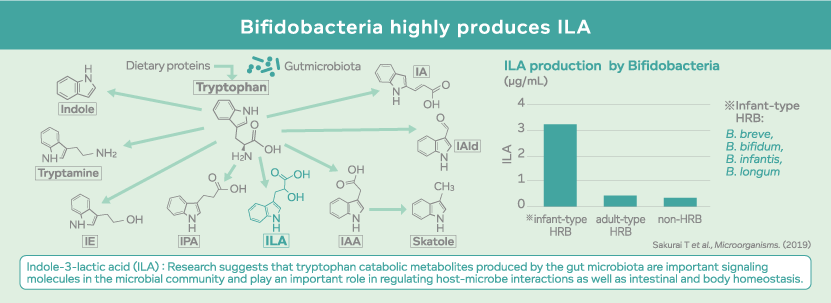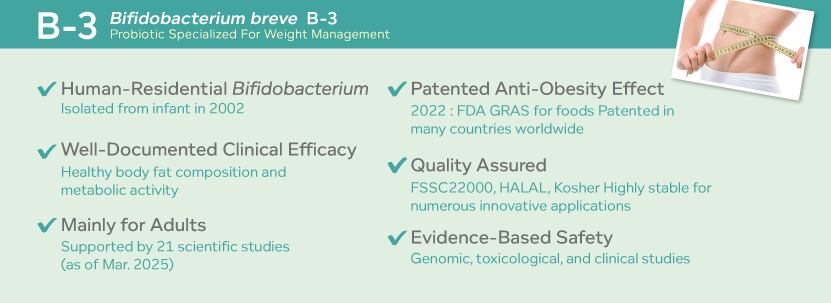Gut microbiota and weight management have been closely linked for decades.
The gut microbiota is a complex environment consisting of trillions of organisms. Maintaining a healthy and diverse gut environment can help to reduce gut permeability and systemic low-grade inflammation which contributes to chronic diseases. When functioning optimally, gut microbiota ferments dietary fibres into short-chain fatty acids (SCFA), such as acetate and butyrate, which are key metabolic mediators.
SCFAs have several functions, including maintaining gut barrier integrity and reducing systemic inflammation. They also stimulate the release of glucagon-like peptide-1 (GLP-1) from intestinal L-cells, which supports insulin production and appetite suppression.¹
Disruptions in the gut microbiota ecosystem, caused by factors such as lifestyle or antibiotic intake, knows as gut microbiota dysbiosis, may lead to inflammation and body fat accumulation, increasing the risk of various diseases.
Recent studies are further investigating the mechanism of how dysbiosis will affect the different functions of the body and cause various conditions, such as increased absorption of calories or disruption of the gut barrier function.
Research shows that gut microbiota dysbiosis, triggered by diets high in fat, animal protein and low in fibre, can impair gut barrier function and contribute to obesity.² Harmful microbial byproducts increase intestinal permeability, leading to inflammation and altered energy balance. These changes can promote fat storage, disrupt metabolic regulation and activate stress pathways – all of which contributes to obesity.

Studies have also shown the connection between the gut microbiota and metabolic syndrome, a cluster of conditions that increase the risk of non-communicable diseases such as heart disease, stroke and type 2 diabetes.
Obesity and its growing impact
Obesity is one of the key components of metabolic syndrome. A body mass index (BMI) over 30 is classified as obesity.³ Since 1990, global rates of adult obesity have more than doubled, and adolescent obesity has quadrupled. Obesity not only increases the risk of non-communicable disease but it is also associated with increased risks of complications following surgery, such as infections, blood clots and kidney issues.
As obesity and relevant risks become a growing concern, interest in metabolic health is rising. Beneficial bacteria, especially Bifidobacterium, have shown promise in positively influencing the gut environment and are recognised as a way in which to approach obesity. For another example, Faecalibacterium is known to produce butyrate and offers anti-inflammatory and gut-protective benefits.
In fact, inflammation occurs in obese people, and the balance of tryptophan (Trp) metabolism is also altered in obesity. C-reactive protein and IL-6 are higher in obese people. A 2020 study showed that there is a strong negative correlation between inflammatory markers and indole-3-lactic acid (ILA).⁴ Therefore, ILA produced by intestinal bacteria are very important points when considering anti-obesity and weight management.
Human-Residential Bifidobacteria and ILA
A 2019 study evaluated the capacity of Bifidobacterium strains to produce various Trp metabolites.⁵ The study revealed that infant-type human-residential bifidobacteria (HRB) produced significantly higher levels of ILA compared with adult-type HRB and non-HRB strains.
In addition, studies have shown that HRB contains the gene to convert indole, a precursor of uremic toxin, into beneficial ILA. For example, a 2024 proof-of-concept study showed that certain strains of Bifidobacterium can convert indole into ILA.⁶
The conversion involves two key enzymes: tryptophan synthase β subunit and aromatic lactate dehydrogenase. The study showed that only specific Bifidobacterium strains with these genes can carry out this transformation, revealing a previously unknown pathway. This suggests a new health-promoting role for Bifidobacterium, helping to detoxify indole while producing beneficial metabolites.

B. breve B-3: Clinical evidence for metabolic benefits
Bifidobacterium breve B-3, an infant type HRB strain, is known for its ability to produce ILA, which supports immune regulation and inflammation suppression. Research suggests that tryptophan-derived metabolites like ILA act as signaling molecules that help maintain host-microbe balance and intestinal and body homeostasis.

Several clinical studies have demonstrated the metabolic benefits of B-3:
- 50 billion CFU/day for 12 weeks in healthy adults (BMI 24–30) Significant reductions in body weight and fat mass, along with improved liver function and inflammation markers (γ-GTP and hs-CRP).⁷
- 20 billion CFU/day for 12 weeks in adults (BMI 25–30) Reduced body fat, increased muscle mass and decreased waist circumference.⁸
- 5 billion CFU/day for 12 weeks in 83 healthy adults (BMI 25–30) Significant reductions in body fat mass, body weight, BMI, waist and hip circumference.⁹
These studies consistently showed improvements in body composition across different dosages, without requiring dietary or exercise interventions – highlighting B-3’s potential in supporting metabolic health.
A 2024 systematic review and meta-analysis titled ‘Effect of Bifidobacterium Intake has effect in Body Weight and Body Fat in Overweight and Obese Adult Subjects’ further supports these findings, emphasising Bifidobacterium’s roll in alleviating inflammation and preventing fat accumulation, key health challenges for millions of consumers faced with obesity.¹⁰

B. longum BB536: Modulating the gut environment
A 2024 randomised, placebo-controlled, double-blind, parallel-group study conducted by Morinaga Milk investigated the effects of Bifidobacterium longum BB536 on the gut microbiota composition and metabolite profiles in healthy individuals.¹¹ It compared the effects of fermented milk produced solely with Streptococcus thermophiles and Lactobacillus bulgaricus (placebo group) or fermented milk supplemented with BB536 (BY group).
The findings revealed a significantly higher abundance of Faecalibacterium in the BY group than in the placebo group by Day 3 and until the end of the trial on Day 17. Additionally, the BY group presented significantly increased concentrations of tryptophan, ILA, and Indole-3-aldehyde on the final day. These results suggest that BB536 can positively modulate gut microbiota composition and metabolite profiles – key indicators of gut health.
Science-backed probiotics for metabolic health
As metabolic health increasingly comes under the spotlight globally, probiotics like B. longum BB536 and B. breve B-3 offer promising, clinically supported solutions. Morinaga Milk continues to lead in providing clinically backed strains that enhance product efficacy and consumer trust, helping brands deliver functional products that resonate with health-conscious consumers.
References
- Tolhurst, G.; et al. Short-chain fatty acids stimulate glucagon-like peptide-1 secretion via the G-protein-coupled receptor FFAR2. Diabetes. 2012 Feb;61(2):364-71.
- Pillai, S.; et al. Exploring the Gut Microbiota: Key Insights Into Its Role in Obesity, Metabolic Syndrome, and Type 2 Diabetes. The Journal of Clinical Endocrinology & Metabolism, 2024;109 (11); 2709–2719.
- World Health Organization. Obesity and overweight.
- Cussotto, S.; et al. Tryptophan Metabolic Pathways Are Altered in Obesity and Are Associated With Systemic Inflammation. Frontiers in Immunology. 2020;11.
- Sakurai, T.; e al. Production of Indole-3-Lactic Acid by Bifidobacterium Strains Isolated from Human Infants. Microorganisms, 2019;7(9), 340.
- Yong, C.C.; et al. Human gut-associated Bifidobacterium species salvage exogenous indole, a uremic toxin precursor, to synthesize indole-3-lactic acid via tryptophan. Gut Microbes. 2024 Jan-Dec;16(1):2347728.
- Minami, J.I.; et al. Oral administration of Bifidobacterium breve B-3 modifies metabolic functions in adults with obese tendencies in a randomised controlled trial. Journal of Nutritional Science. 2015;4:e17.
- Minami, J.; et al. Effects of Bifidobacterium breve B-3 on body fat reductions in pre-obese adults: a randomized, double-blind, placebo-controlled trial. Bioscience of Microbiota, Food and Health, 2018;37(3):67-75.
- Sung, H.K.; et al. Body Fat Reduction Effect of Bifidobacterium breve B-3: A Randomized, Double-Blind, Placebo Comparative Clinical Trial. Nutrients. 2022 Dec 21;15(1):28.
- Riveros, N.; et al. Effect of Bifidobacterium Intake on Body Weight and Body Fat in Overweight and Obese Adult Subjects: A Systematic Review and Meta-Analysis. Journal of the American Nutrition Association, 43(6), 519–531.
- Ejima, R.; et al. The Impact of Fermented Milk Products Containing Bifidobacterium longum BB536 on the Gut Environment: A Randomized Double-Blind Placebo-Controlled Trial. Nutrients. 2024; 16(21):3580.



